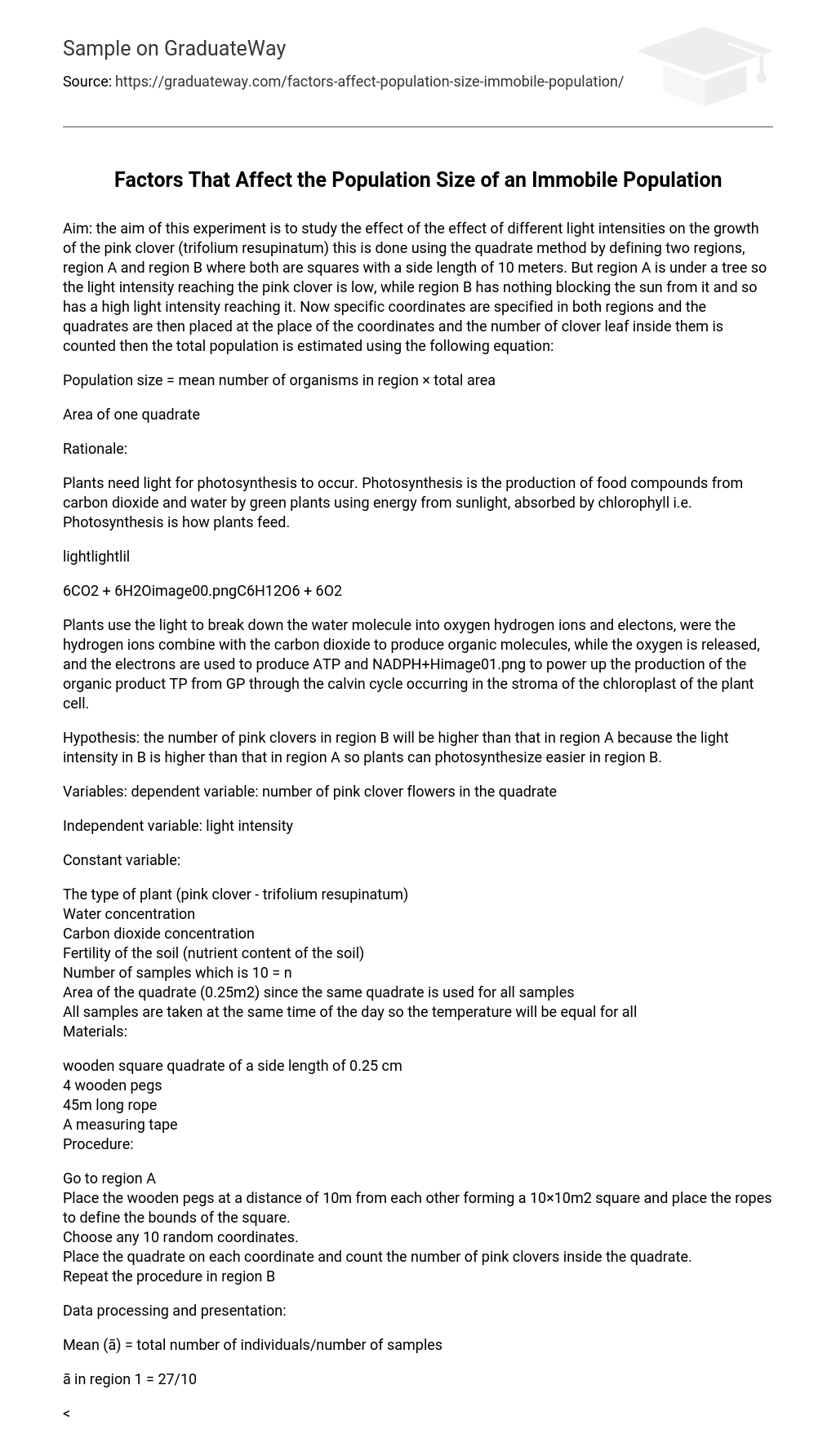Aim: the aim of this experiment is to study the effect of the effect of different light intensities on the growth of the pink clover (trifolium resupinatum) this is done using the quadrate method by defining two regions, region A and region B where both are squares with a side length of 10 meters. But region A is under a tree so the light intensity reaching the pink clover is low, while region B has nothing blocking the sun from it and so has a high light intensity reaching it. Now specific coordinates are specified in both regions and the quadrates are then placed at the place of the coordinates and the number of clover leaf inside them is counted then the total population is estimated using the following equation:
Population size = mean number of organisms in region × total area
Area of one quadrate
Rationale:
Plants need light for photosynthesis to occur. Photosynthesis is the production of food compounds from carbon dioxide and water by green plants using energy from sunlight, absorbed by chlorophyll i.e. Photosynthesis is how plants feed.
lightlightlil
6CO2 + 6H2Oimage00.pngC6H12O6 + 6O2
Plants use the light to break down the water molecule into oxygen hydrogen ions and electons, were the hydrogen ions combine with the carbon dioxide to produce organic molecules, while the oxygen is released, and the electrons are used to produce ATP and NADPH+Himage01.png to power up the production of the organic product TP from GP through the calvin cycle occurring in the stroma of the chloroplast of the plant cell.
Hypothesis: the number of pink clovers in region B will be higher than that in region A because the light intensity in B is higher than that in region A so plants can photosynthesize easier in region B.
Variables: dependent variable: number of pink clover flowers in the quadrate
Independent variable: light intensity
Constant variable:
The type of plant (pink clover – trifolium resupinatum)
Water concentration
Carbon dioxide concentration
Fertility of the soil (nutrient content of the soil)
Number of samples which is 10 = n
Area of the quadrate (0.25m2) since the same quadrate is used for all samples
All samples are taken at the same time of the day so the temperature will be equal for all
Materials:
wooden square quadrate of a side length of 0.25 cm
4 wooden pegs
45m long rope
A measuring tape
Procedure:
Go to region A
Place the wooden pegs at a distance of 10m from each other forming a 10×10m2 square and place the ropes to define the bounds of the square.
Choose any 10 random coordinates.
Place the quadrate on each coordinate and count the number of pink clovers inside the quadrate.
Repeat the procedure in region B
Data processing and presentation:
Mean (ā) = total number of individuals/number of samples
ā in region 1 = 27/10
= 2.7
Population size = mean number of organisms in region × total area of region
Area of one quadrate
Size of population = 2.7× (0.25 × 121)
0.25
=
ā in region 2 = 313/10
= 31.3
Size of population= 31.3× (0.25 × 121)
0.25
Conclusion and evaluation:
As it can be seen from the results my hypothesis was proved correct which is that pink clovers (trifolium resupinatum) have a more numerous population in regions of higher light intensity, so pink clovers were more numerous in region B. however the experiment results are not a hundred percent accurate, because even the constant may vary, for example region B was higher than region A so leaching of nutrients from region A to region B, which may have contributed to the more numerous population of pink clover in region B, so the soil can not be actually classified as a constant. Moreover it is impossible to keep water constant because less water evaporates from the soil of the shaded area which is region A , however the tree which shades region A also absorbs much water from the region, in addition to all the other plants in both regions which cant be controlled for sure. Temperature couldn’t have been constant, since the shaded region is cooler than the sunny region and hence enzyme activity and metabolic rate was higher for pink clovers in region B. last but not least due to the random sampling we only have estimates, because of we took other coordinates we may have higher or lower means for the values and so the total population will value.
To solve all these problems the experiment can be conducted inside a botanic garden so that all the variables will be controlled and increasing the number of samples taken so that the results would be more accurate.





